

a way to measure 90° angles (speedsquare, welding magnets, etc)Ī while ago I made 2 box joint jigs around the time I got a cheap 3rd hand table saw.box joint jig if you're doing box joints.A way to cut square edges (table saw + sled, miter box/saw, etc).Next time I would put paper between them so only the paper gets glued on. They got glued on so I removed them with a chisel. See the photos for a clearer explanation. I clamped on the sides as well as put scraps board on top and bottom and clamped those to keep everything straight.

With bigger pieces I would have just glued 2, max 3 pieces at the same time but because these cutoffs were so small and this whole project started as a test anyway I did all 5 at the same time. The more pieces you glue in one go, the more likely they will "cup" and curve. I glued 5 pieces together in a single glue-up. Then we apply glue to the sides of the workpieces and clamp them all together. A short plane will also plane, but if your workpiece is curved, it will just follow the curvature of the workpiece. The shorter the plane, the less of a straightening effect you will have. It's important that the (block) planer you're using has a body as long as you can get. I'm more comfortable using a plane on small pieces like this than I am with running them through a table saw.

You can also do this with a table saw, but I chose to use a block plane because: A jointer would be perfect for this, but I don't have one. I did this by bundling up a bunch of them, clamping them to my workbench and running a long plane over them. What this means is you make the edges as close to perfectly straight as you can get it.


 0 kommentar(er)
0 kommentar(er)
